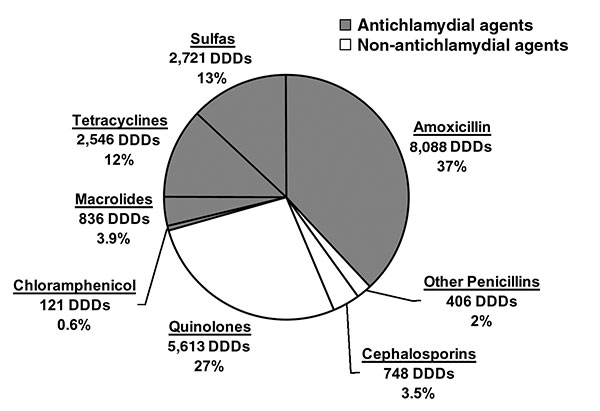Volume 10, Number 11—November 2004
Perspective
Trachoma Decline and Widespread Use of Antimicrobial Drugs
Figure 1

Figure 1. Antimicrobial drug use in Geta, Nepal. Antimicrobial drug sales in a 3-month period (mid-February to mid-May 2000) from all pharmacies in the Geta subdistrict, expressed as defined daily doses (DDDs) and as a percentage of the total DDDs sold (6). The shaded region represents antimicrobial drugs that are effective against Chylmydia trachomatis.
References
- Dolin PJ, Faal H, Johnson GJ, Minassian D, Sowa S, Day S, Reduction of trachoma in a sub-Saharan village in absence of a disease control programme. Lancet. 1997;349:1511–2. DOIPubMedGoogle Scholar
- Pokhrel G, Baral K, Boulter A, Regmi G. Study of community trachoma control programs in Banke, Bardia, and Kailali Districts of western Nepal. In: XVI Congress of Asia Pacific Academy of Ophthalmology. Katmandu, Nepal: Asian Pacific Academy of Ophthalmology; 1997.
- Taylor H. Towards the global elimination of trachoma. Nat Med. 1999;5:492–3. DOIPubMedGoogle Scholar
- Hoechsmann A, Metcalfe N, Kanjaloti S, Godia H, Mtambo O, Chiopeta T, Reduction of trachoma in the absence of antibiotic treatment: evidence from a population-based survey in Malawi. Ophthalmic Epidemiol. 2001;8:145–53. DOIPubMedGoogle Scholar
- Jha H, Chaudary J, Bhatta R, Miao Y, Osaki-Holm S, Gaynor B, Disappearance of trachoma in western Nepal. Clin Infect Dis. 2002;35:765–8. DOIPubMedGoogle Scholar
- Schiedler V, Bhatta RC, Miao Y, Bird M, Jha H, Chaudary J, Pattern of antibiotic use in a trachoma-endemic region of Nepal: implications for mass azithromycin distribution. Ophthalmic Epidemiol. 2003;10:31–6. DOIPubMedGoogle Scholar
- World Health Organization. Report of the first meeting of the Who Alliance for the Global Elimination of Trachoma. Geneva: The Organization; 1997.
- Thylefors B, Dawson CR, Jones BR, West SK, Taylor HR. A simple system for the assessment of trachoma and its complications. Bull World Health Organ. 1987;65:477–83.PubMedGoogle Scholar
- Holm SO, Jha HC, Bhatta RC, Chaudhary JS, Thapa BB, Davis D, Comparison of two azithromycin distribution strategies for controlling trachoma in Nepal. Bull World Health Organ. 2001;79:194–200.PubMedGoogle Scholar
- Ridgway G. Treatment of chlamydial genital infection. J Antimicrob Chemother. 1997;40:311–4. DOIPubMedGoogle Scholar
- Suchland RJ, Geisler WM, Stamm WE. Methodologies and cell lines used for antimicrobial susceptibility testing of Chlamydia spp. Antimicrob Agents Chemother. 2003;47:636–42. DOIPubMedGoogle Scholar
- Anatomical therapeutic chemical classification index with defined daily doses. 3rd ed. Oslo, Norway: WHO Collaborating Centre for Drug Statistics Methodology and the Nordic Council on Medicines; 2000.
- Lietman T, Porco T, Dawson C, Blower S. Global elimination of trachoma: how frequently should we administer mass chemotherapy? Nat Med. 1999;5:572–6. DOIPubMedGoogle Scholar
- Muñoz B, West S. Trachoma: the forgotten cause of blindness. Epidemiol Rev. 1997;19:205–17.PubMedGoogle Scholar
- Emerson PM, Cairncross S, Bailey RL, Mabey DC. Review of the evidence base for the ‘F’ and ‘E’ components of the Safe Strategy for Trachoma Control. Trop Med Int Health. 2000;5:515–27. DOIPubMedGoogle Scholar
- Gaynor BD, Yi E, Lietman T. Rationale for mass antibiotic distribution for trachoma elimination. Int Ophthalmol Clin. 2002;42:85–92.PubMedGoogle Scholar
- Lewallen S, Courtright P. Blindness in Africa: present situation and future needs. Br J Ophthalmol. 2001;85:897–903. DOIPubMedGoogle Scholar
- Emerson PM, Lindsay SW, Walraven GE, Faal H, Bøgh C, Lowe K, Effect of fly control on trachoma and diarrhoea. Lancet. 1999;353:1401–3. DOIPubMedGoogle Scholar
- West S, Muñoz B, Lynch M, Kayongoya A, Chilangwa Z, Mmbaga BB, Impact of face-washing on trachoma in Kongwa, Tanzania. Lancet. 1995;345:155–8. DOIPubMedGoogle Scholar
- West SK, Muñoz B, Lynch M, Kayongoya A, Mmbaga BB, Taylor HR. Risk factors for constant, severe trachoma among preschool children in Kongwa, Tanzania. Am J Epidemiol. 1996;143:73–8.PubMedGoogle Scholar
- Taylor HR, West SK, Mmbaga BB, Katala SJ, Turner V, Lynch M, Hygiene factors and increased risk of trachoma in central Tanzania. Arch Ophthalmol. 1989;107:1821–5.PubMedGoogle Scholar
- Emerson PM, Bailey RL, Mahdi OS, Walraven GE, Lindsay SW. Transmission ecology of the fly Musca sorbens, a putative vector of trachoma. Trans R Soc Trop Med Hyg. 2000;94:28–32. DOIPubMedGoogle Scholar
- Emerson PM, Lindsay SW, Alexander N, Bah M, Dibba SM, Faal HB, Role of flies and provision of latrines in trachoma control: cluster-randomised controlled trial. Lancet. 2004;363:1093–8. DOIPubMedGoogle Scholar
- Bailey RL, Arullendran P, Whittle HC, Mabey DC. Randomised controlled trial of single-dose azithromycin in treatment of trachoma. Lancet. 1993;342:453–6. DOIPubMedGoogle Scholar
- Dawson CR, Schachter J, Sallam S, Sheta A, Rubinstein RA, Washton H. A comparison of oral azithromycin with topical oxytetracycline/polymyxin for the treatment of trachoma in children. Clin Infect Dis. 1997;24:363–8. DOIPubMedGoogle Scholar
- Schachter J, West SK, Mabey D, Dawson CR, Bobo L, Bailey R, Azithromycin in control of trachoma. Lancet. 1999;354:630–5. DOIPubMedGoogle Scholar
- Ministry of Health, Child Health Division. Technical guidelines on the control of acute respiratory infections. Kathmandu: Government of Nepal; 1994.
- Integrated management of childhood illness information: adaptation of the integrated management of childhood illness technical guidelines and training materials. WHO/CAS/CAH/98.1D/REV.1/1999. WHO and UNICEF; 1999.
- Regional Malaria Database. Drug regimen South East Asia region [database on the Internet]. World Health Organization, Regional Office for South East Asia (India); 2001 [cited 2004 Nov]. Available from http://w3.whosea.org/malaria/database6.htm
Page created: April 22, 2011
Page updated: April 22, 2011
Page reviewed: April 22, 2011
The conclusions, findings, and opinions expressed by authors contributing to this journal do not necessarily reflect the official position of the U.S. Department of Health and Human Services, the Public Health Service, the Centers for Disease Control and Prevention, or the authors' affiliated institutions. Use of trade names is for identification only and does not imply endorsement by any of the groups named above.